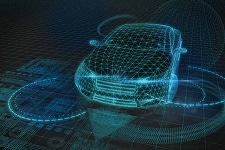Connected and autonomous vehicle development and safety
Connected and automated vehicle (CAVs) technologies present significant and potentially transformational opportunities – for society and the individual. It promises safer roads and less congestion, as well as greener and more accessible transport. Indeed, the global CAV market is predicted to reach over £900 bn by 2035. Find out how standards are helping drive progress in connected and autonomous vehicle (CAVs) technology.
 Connected and automated vehicle (CAVs) technologies present significant and potentially transformational opportunities – for society and the individual. It promises safer roads and less congestion, as well as greener and more accessible transport. Indeed, the global CAV market is predicted to reach over £900 bn by 2035.
Connected and automated vehicle (CAVs) technologies present significant and potentially transformational opportunities – for society and the individual. It promises safer roads and less congestion, as well as greener and more accessible transport. Indeed, the global CAV market is predicted to reach over £900 bn by 2035.
The UK government established the Centre for Connected and Autonomous Vehicles (CCAV) in 2015 to shape the safe and secure emergence of CAV technology. BSI is working in partnership with CCAV and the UK CAV Eco-system, organizations involved in trialling CAV technologies, to accelerate the safe and secure deployment of CAVs, starting with trialling and developmental testing.
Understandably, one of the most important areas of CAV technology progression surrounds user and consumer safety. This is central to gradually building mainstream trust and comfort with the concept, as CAVs will operate with little or no human input.
As a result, much of the recent guidance published to date relates in some way to developing safe systems. For example, PAS 1880, provides a set of initial guidelines focused on developing safe control systems for automated vehicles (AVs).
Similarly, PAS 1881 is designed to assure the safety of related trialling and developmental testing activities alongside CCAV’s own Code of Practice. This specification determines minimum safety case requirements for AV trials and development testing in the UK to demonstrate such activities can be undertaken safely.
PAS 1883, meanwhile, provides a universal taxonomy for specifying the operational design domain (ODD), or intended operating conditions, of an automated driving system (ADS). The ODD comprises the static and dynamic attributes within which an ADS is designed to function safely. The PAS can help organizations deploying CAV technologies to specify the operating environment of the vehicle in a clear language, prevent confusion, and communicate a shared view of the capabilities of the vehicle (and its limitations).
A further, vitally important, consideration for those in the CAV development ecosystem is cybersecurity. Vehicles are already increasingly connected to infrastructure and the IoT. This trend is set to continue and is particularly important for CAVs.
As technology progresses, vehicles will get smarter and their connectivity and integration with outside systems will deepen. As a result, cybersecurity is a serious focus for all those involved with CAVs.
PAS 1885 outlines key cybersecurity principles in this context, helping users reduce threats and harm to products, services and systems within increasingly connected and collaborative intelligent transport ecosystems (vehicles, infrastructure, and human aspects).
The PAS has been designed to apply to the security and functional safety aspects of the development and use lifecycle, which is important to tackle constantly evolving cybersecurity risks.
Further to this, PAS 11281 aims to help organizations in the CAV ecosystem ensure that their products, services or activities don’t pose unacceptable safety risks, while a new international standard due to publish in 2021, ISO/SAE 21434 Automotive cybersecurity engineering, will help the automotive industry adopt the new UNECE Cyber Security Regulations for Vehicles.
With a rise in the testing and trialling of fully automated or ‘driverless’ vehicles, production vehicles and cars on our roads now are also becoming more intelligent and ‘automated’ with new driver assistance, safety and convenience features sometimes called ADAS (Advanced Driver Assistance Systems).
The following standards provide performance requirements and test procedures for such systems to help ensure they are safe for deployment on production vehicles.
- lane-keeping assistance systems (BS ISO 11270)
- curve speed warning systems (BS ISO 11067)
- adaptive cruise control systems (BS ISO 15622)
- forward collision warning systems (ISO 15623)
- road boundary departure prevention systems (BS ISO 19638)
It is expected that the automotive industry will see a move from ‘assisted’ driving systems to ‘automated’ driving over the coming years.

